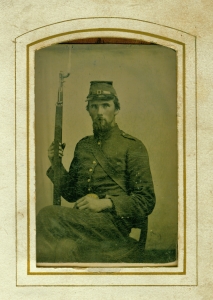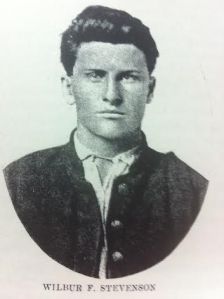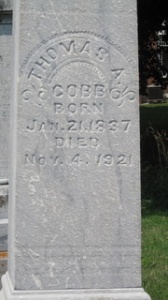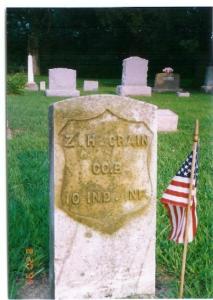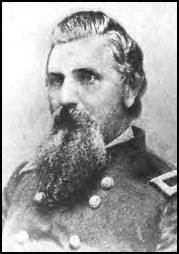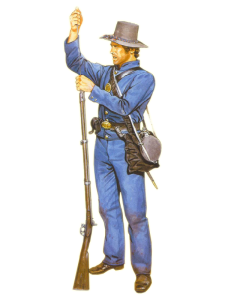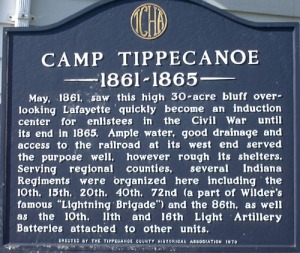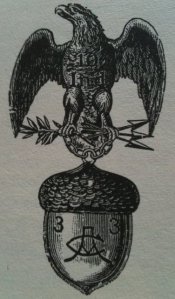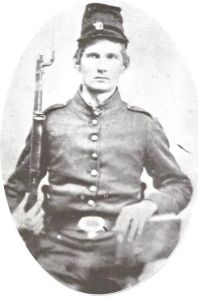Possible 10th Indiana Infantry image located in Montgomery County, Indiana. This image is in a private collection and was scanned by the Crawfordsville District Public Library. There are several similarities to other known images of 10th Indiana soldiers. This soldier is wearing a forage cap and Indiana State Jacket, this was common for many Indiana regiments. The cartridge box sling does not have a breastplate, this is consistent with other known images of the 10th. This soldier is also holding an Enfield rifle musket. While it would be a common arm to many Hoosier regiments, the 3 year 10th Indiana received their Enfield’s after being in Kentucky for about month. A very exciting image.
Wilbur Stevenson, Company D
“HISTORY OE THE TENTH INDIANA VOLUNTEER INFANTRY ”
Wilbur F. Stevenson.
Mr. Stevenson was born in Scott County, Kentucky, November 12, 1842. Parents, Evan Stevenson and Lydia Boggs Stevenson. The family moved to Benton County, Indiana, in
1856. He attended school at the “Battle Ground” in i860 and 1861. He enlisted in Company D. Tenth Indiana Infantry, September 6, 1861 ; was made Corporal and later promoted to Sergeant. His service was marked by nothing unusual interest until the battle of Chickamauga, where he “stopped a bullet with his knee.” After partial recovery he
did hospital duty at Madison, Ind., until the expiration of his term of enlistment. He went to school in LaFayette in 1865. Moved to Piatt County, Illinois, in 1868. Married Alice Tall-
man in 1871. Has five children — Evan Stevenson, born in 1872; Mrs. W. H. Dilatush, born in 1876; Mrs. C. B. Caldwell, born in 1883; Mrs. J. W. Ayre, born in 1884; Mrs. E.
J. Hawbaker, born in 1889. He has served terms as Supervisor of Piatt County and as Mayor of Monticello, but has managed, so far, to “side step the penitentiary.” In politics
he was originally a Republican, but becoming disgusted at the mean treatment of the Southern people during the reconstructtion period he “reformed” (Oh, Lord) and embraced Democracy. His principal business interests have been farming and the feeding of cattle and hogs.
The above was written by himself. It is a mystery how the “political reformation” of this fellow kept him out of the pen. That of itself was a sufficient crime to cause a life sentence.
Capt. Thomas A. Cobb, Company A
“HISTORY OF THE TENTH INDIANA VOLUNTEER INFANTRY ”
Captain Thomas A. Cobb.
Grave of Capt. Cobb, Mounts Runn Baptist Cemetery, Whitestown, Ind.
Thomas A. Cobb was born in Harrison County, Ohio, on
his father’s farm, January 21, 1837, received a good education
in Ohio and afterward attended the Thorntown Academy and
Duff’s Mercantile College, Pittsburg, Pa.
At the age of seventeen he located in Boone County,
Indiana, and assisted his father in clearing up his farm and
was early inured to hard work. In August, 1861, he enlisted
at the age of 24 years in Company A, Tenth Indiana Infantry,
and was elected First Lieutenant of his company. He held
this position until November 18, 1862, when he was commis-
sioned Captain, caused by the resignation of Captain James
H. Hamilton on that date. Captain Cobb was an excellent
officer, rather of a retiring disposition, yet congenial when in
company with others. In battle he was always cool and de-
liberate in his actions, brave in the extreme but not reckless.
His men had perfect confidence in him and would stand by
him under the most trying circumstances.
He was present at and participated in all the battles in
which the regiment was engaged, viz. : Mill Springs, Ky.,
Pittsburg Landing, Corinth, Boonville, Miss., Perryville, Ky.,
Hoover’s Gap, Chickamauga, Ga. (two days), Mission Ridge,
Tenn., Tunnel Hill, Buzzard Roost, Kingston, Kenesaw
Mountain, Peach Tree Creek, and Atlanta, Ga. At Chick-
amauga his company saved the battery (C, First Ohio) from
capture by dragging the guns away by hand.
In all his military service he was a brave and discreet
officer and won the respect of the entire regiment. After a
service of three years and one month he was honorably mus-
tered out September 19, 1864.
After his return from the army he resumed farming in
Boone County. He was married to Julia A. Wilharm, daugh-
ter of Gotlieb and Amelia (Zumphe) Wilharm. Captain Cobb
has made an enviable record as a leading educator of Boone
County. He began teaching in Marion Township in 1857.
In 1859 he went to Missouri, where he taught school and re-
turned to Marion Township and continued to teach up to time
of his enlistment in the army. After the war he taught school
for six years in the home district. In the spring of 1865 he
settled on his farm, consisting at that time of 120 acres, and
has gradually added thereto until he now owns 400, one of
the finest farm properties in Boone County.
Politically he was a Douglas Democrat, but voted for
Greeley in 1872, and afterward for Peter Cooper. He then
voted for Ben Harrison and is now a Populist. He is a mem-
ber of Rich Mountain Post No. 42, Lebanon, Ind., and a
member of the Knights of Pythias.
From the union six children were born, Addie A. and
Eva A. (twins). Emma B., George M., Thomas A., and Julia
L.. all living. His wife died August 24. 1893.
Zephaniah Crain, Company B.
Grave of Z.H. Crain, Mace Cemetery, Mace, Indiana
Zehpahiah H. Crain was born in 1818 at Warren County, Ohio. He was the son of Elihu Crain/Crane (b. 1775), the family moved to Montgomery County, Indiana sometime before 1830. Elihu was one of the founding members of the Sugar Creek Baptist Church in 1823, according to church records. The family farmed in Walnut Township around the area of Fredericksburg; modern day Mace. Zephaniah married Sarah J. Busenbark; daughter of Redden Busenbark on February 25, 1848. Zephaniah’s farm was about 1/2 mile northeast of Fredericksburg, modern day Interstate 74 cuts through Zeph’s home place.
With the Civil War already in progress, many of the three month regiments had returned home, their term of enlistment had expired. Most of these regiments would re-organize for three year service. In Montgomery county the 10th Indiana Infantry was recruiting men for three year service. At the age of 42; Zephaniah made the 4 mile trip to Crawfordsville and on September 18, 1861 enlisted in the “Crawfordsville Guard”. After the company was organized, the recruits traveled to Lafayette, IN. and went into quarters at Camp Tippecanoe for training. They were designated as Company B, 10th Indiana Infantry. The regiment would soon be off to Kentucky; where they were still learning to be soldiers.
Zephaniah soon found himself in eastern Kentucky, around the area of Somerset. On the morning of January 19, 1862 Zeph and the rest of the regiment were sleeping in their camp near Logan’s Cross Roads. They were awakened by the sounds of musket fire, the Confederate Army was attacking the Union camps in this area. The 10th Indiana was quickly formed in line of battle and marched toward the skirmish line, they would be one of the first infantry regiments engaged at the battle of Mill Springs, Kentucky. The 10th Indiana was in for a long day; Zephaniah’s company would be in the thick of the fight throughout day. Company B had the highest casualties in the 10th Regiment; 3 killed and 21 wounded, one of whom was Zephaniah. He had been hit by a ball on the left wrist at some point in the battle, but would soon recover. General G.H. Thomas had led his Union troops to victory, and the men had proven themselves soldiers to their commander; they had stood their ground and fought well.
The 10th Indiana would march into Tennessee, across the Shiloh battlefield and south to Corinth, MS. where the Union army was laying siege to the Confederate Army that had retreated from Shiloh. By May 30, 1862 the Confederates had evacuated the works and would move to Chattanooga, then north into Kentucky. Confederate General Bragg had hopes of pushing the Union Army out of Kentucky, and hoped to draw thousands of new recruits into his army. The Union Army started to move north also, the race to Louisville would be on between the two armies. The Federals would reach the city first, Zephaniah , with the rest of the army had made a forced march through Kentucky under severe drought conditions. The troops were re-equipped and marched out of Louisville in search of the Confederate Army.
By the evening of October 7, 1862 the 10th Indiana was near the town of Perryville, Kentucky. A portion of the Confederate Army was found drawn up in line of battle close to town. The 10th Indiana was posted near one of few water supplies in the area; Doctor’s Creek. As the drought continued, water was a precious commodity to both armies. Early on the morning of October 8th Confederate troops were placed on Peter’s Hill, which overlooked Doctor’s Creek. Around 5 A.M. Zephaniah’s regiment was ordered to engage the enemy posted on Peters Hill. Two Confederate regiments, the 6th and 7th Arkansas, were posted on top of the hill.
Following is the after action report of Colonel William Kise; 10th Indiana Infantry. …….. “Nothing further occurred until 5 A. M. when the regiment was formed in line of battle and moved across an open field about a half-mile, when the skirmishers under Captain Johnson were again fired upon by the enemy. I arrived on the field at 7 A. M. and took command. Soon after I relieved Captain Johnson’s company of skirmishers by sending forward Company B, Captain Goben, to take their place, which position Captain Goben maintained, skirmishing with the enemy occasionally until about 12 o’clock noon, when by your order, moved the regiment out of the woods, across an open field under fire of shot and shell from a battery of the enemy. Crossing a rail and stone fence, and ascending a steep hill, followed to our left, and somewhat in our rear by the Eighty-sixth Illinois under command of Colonel Irons.
We came upon a force of the enemy outnumbering us, who at once opened a galling fire upon us which was returned by my regiment.
Company B, Captain Goben being the left flanking company and near where the enemy was in heavy force under cover of a rail fence and under the slope of a hill sustained the brunt of the battle, suffering the loss of four killed and three wounded; but the captain leading his men stood up resolutely, and after my regiment had obstinately contested the ground for twenty minutes, the enemy gave way and fled in confusion, leaving their dead and wounded on the field.”
At some point during the charge up Peter’s Hill, Zephaniah received a severe wound. It was not by enemy artillery or muskets; but by someone from his own company. In Zephaniah’s pension paperwork, the regimental surgeon; under oath, explains what happened that day. ” That at the battle of Perryville in the state of Kentucky on the 8th day of October 1862, while making a charge on the enemy, Zephaniah H. Crain, a private in Co. B, of said 10th Reg’t. Ind. Vols., while in the service of the United States and in the line of his duty was injured in the left eye, by being struck in the eye by a bush which was violently jerked down by one of the men of said company, who had seized hold of the brush to aid himself in climbing the hill.
I treated him for said injury for only a few days and then submitted him to the General Hospital. On account, and by reason of the injury above described, said eye inflamed and the sight of said eye was thereby entirely destroyed.”
Zephaniah would be in the hospital for several months, Perryville would be his last battle. He was not finished with the military though, he was transferred to Company A; 8th Regiment, Veteran Reserve Corps, October 1, 1863. The Veteran Reserve Corps (V.R.C.) were soldiers who could not perform normal field duties, they were used as guards of prisoners or placed at other low key duty stations to free up fit troops for the field. When his term of 3 years came up, he re-enlisted in the V.R.C., he would muster out in 1865, it seems that serving his country was important to Zephaniah. As stated before he applied for a soldiers pension and it was granted to him. In his later years his eye wound was still giving him trouble, a doctor stated that it had “sunken back in the socket and still drained fluid.” Zephaniah Crain lived the rest of his life with scars from a random battlefield accident, he would carry a small part of Perryville with him until his death. He was proud of his service; belonging to the Grand Army of the Republic, Abe Lincoln Post #24 in Mace, Indiana. Zephaniah died on August 23, 1898, he is buried in the Mace K of P Cemetery. His daughter Malinda married Samuel Landis Busenbark in Montgomery County, Indiana.
General Mahlon D. Manson
Mahlon Dickerson Manson was born February 20, 1820, in Piqua, Ohio. He received a common school education and later moved to Montgomery County, Indiana where he taught school for a year. He briefly studied medicine in Cincinnati at the Ohio Medical College. From October 8, 1847 to July 28, 1848, he served as captain of the 5th Indiana Volunteers in the Mexican War. He was a member of the State House of Representatives in 1851-1852 and was a druggist in Crawfordsville. Manson was mustered into service April 17, 1861, as captain of the 10th Indiana Infantry and promoted to colonel the following month. He led the regiment at the battle of Rich Mountain in July 1861 and the following January commanded a brigade at Fishing Creek, Kentucky in the defeat of Confederate General F. K. Zollicoffer. He was promoted to Brigadier General March 24, 1862. Colonel Manson was wounded and captured October 30, 1862, in Richmond after his horse took a bullet to the head and rolled on top of him, and he was not exchanged until December. Upon his return to the field, he faced General John Pegram who was plundering beef cattle. Manson commanded the XXIII Corps in Knoxville and a brigade of Cox’s division of the corps (now the Army of Ohio) in the Atlanta campaign. On May 14, 1864, he was severely wounded by the explosion of a shell near Resaca, Georgia. Unable to return to service, he resigned December 21, 1864. Mahlon Dickerson Manson was an unsuccessful Democratic candidate for Lieutenant Governor of Indiana in 1864. He served in Congress from March 4, 1871 to March 3, 1873, but was defeated in his attempt for re-election. He was elected auditor of Indiana in 1878, Lieutenant Governor in 1884, and was appointed collector of internal revenue of the seventh district of Indiana on August 11, 1886. He resigned that position November 5, 1889. Manson died February 4, 1895, in Crawfordsville and was buried in Oak Hill Cemetery.
‘The Boys Were Restless,” Camp Tippecanoe
Life at Camp Tippecanoe, “The boys were restless.”
From the History of the Tenth Indiana Infantry
The reorganization of the Tenth Regiment Indiana Vol-
unteer Infantry began in August, 1861, and rendezvous
at Camp Tippecanoe, LaFayette, Indiana. Nine com-
panies were already in camp and on September 6, 1861, the
last company arrived in camp about 4 o’clock P. M., and after-
ward, known as Company D.
The regiment was recruited in the old Eighth Congres-
sional District and the counties comprising this district were
as follows: Benton, one company; Boone, three companies;
Clinton, two companies; Fountain, one company; Montgomery,
one company ; Tippecanoe, two companies.
The Benton County Company (D) was raised in
Benton, Tippecanoe and Warren, but the credit was given
to Benton. The regiment was supplied with the old fashioned
“wedge tents,” which held about six men ; they were close and
uncomfortable. “Camp Tippecanoe” was located about one
and a half miles south of LaFayette near the old Railroad
Junction of the LaFayette and Indianapolis, Wabash and New
Albany and Salem Railroads. The location of the camp was
good, being on a high hill with plenty of shade and water.
The time of the men was principally employed in learning
how to cook, and “squad drill.” The old muskets furnished
us at that time had neither “lock stock or barrel” and about
the only thing dangerous about them was the “bayonet,” which
some fool was liable to use accidentally or otherwise.
The disposition of the men to break guard was the rule
and not the exception. The “guard house” was a frame con-
struction, made of 4×4 uprights boarded up with plank. It
was a frail institution, and carried no terrors to those who
were “fortunate” enough to become an inmate.
General J. J. Reynolds at this time was in western Vir-
ginia and a grape vine report was that he was surrounded
(Sept. 16th). His brothers, John L, James M., Edward H,
and William F., residing in the city, hurried out to camp, very
excited and urged Colonel Manson to hurry to his relief. Man-
son finally received orders to report to Indianapolis for “muster
in,” and get ready for the front. Everything was hurley bur-
ley. Relatives and friends swarmed the camp to bid the boys
good-bye. The usual scenes were witnessed ; wives, mothers,
sisters and sweethearts wept and moaned, and for awhile it
looked as though the regiment would not get out of camp. To-
ward evening Colonel Manson ordered the guard doubled, and
not a man be allowed to leave camp under any circumstances.
There were already some 30 or 40 in the guard house and they
were ordered kept there until morning, when the regiment
would leave on the early train for Indianapolis. The boys were
restless and wanted to “go to town” once more, but no, they
must stay there. The old saw, “Where -there’s a will there’s
a way,” held good in this case and the prisoners held a “coun-
cil of war,” selected a leader and “planned a campaign.” The
leader ordered them in lineup on the front and ends of the
guard house. They stooped down, secured a good hold with
their fingers under the lower edge of the structure, and every-
thing in readiness the “general” gave orders to “Hee-o’-Hee,”
and in one minute the guard house was lying in the bottom of
the ravine, on the west end of camp, and the men scattered in
the brush and woods “streaking” it for town. The guards
rallied, halted the men and threatened to “shoot.” The rest
of the boys in camp concluded they would go too, so they
formed in solid column, charged the guard line and took ttie
guards with them, guns and all. Nearly all the officers were
down town, and when Manson heard of the stampede he gal-
loped out to camp, organized a patrol of what was left and
started for the city to round up the “deserters.” By three
o’clock in the morning about all of the command was again in
camp. Reveille sounded, roll call was had, and the men ordered
to get breakfast and be ready to march.
This tablet marks the area of Camp Tippecanoe. It was developed years ago and is now in the city of Lafayette.
Badge of Honor
This badge was designed by Miss Eulora Miller of LaFayette, Indiana, and at the reunion of the regiment at Lebanon, Indiana, September 19, 1885, was adopted as the regimental badge. 10th IND.is on the eagles breast. Abbreviation for 3rd Division, 3rd Brigade, Army of the Cumberland on the acorn.
Martin V. Wert, Company B
“HISTORY OF THE TENTH INDIANA VOLUNTEER INFANTRY”
Martin V. Wert, Company B.
Martin V. Wert was born in Fountain County, Indiana,
July 17, 1841, his parents being Henry and Isabelle Wert.
The principal part of his life prior to his entry into the army
was spent on the farm. He attended the county schools, and
graduated in the Fountain County High School in i860.
October I, 1861, he enlisted as a private in Company B,
Tenth Indiana Infantry, and served with that organization
until September 5, 1864, at which time he was transferred to
Company B, Fifty-Eighth Indiana Infantry, serving in that
organization until November 1, 1864, at which time he was
honorably mustered out of the service, having served three
years and one month. His company received the brunt of
battle at Perryville, being on the left of the regiment and
suffered the heaviest loss of any company in the regiment, of
four killed and seven wounded. After- the regiment left Tus-
cumbia, Ala., in July, 1862, and stopped for a few days near
Huntsville, Ala., Lieutenant Snyder, M. V. Wert and Fleet
Martin, Company B, with two men from each of the other
companies of the regiment, and ten men from the Fourth
Kentucky, ten from the Tenth Kentucky and ten from the
Fourteenth Ohio, were detailed to take a special train of ten
cars and get 500 bales of cotton at Decatur, Ala., some forty
miles down the Tennessee River. The men were told to take
sixty rounds of ammunition and one day’s rations. They
were given to understand that they must not be captured.
They were to be ready to start at 3 o’clock a. m., which was
before daylight at that time. They were also told that 500
of our cavalry had gone to the same place, starting at noon
the day before, and that a heavy wagon train had gone with
the cavalry. The men started, got the cotton on the train,
running very slow and making no noise on the way there, but
on the way back the engine and soldiers made plenty of noise.
The detail arrived safely with the cotton. They saw large
numbers of the “Johnnies” at a distance and used plenty of
ammunition on them. A large force of our cavalry was scat-
tered at points along the line which saved the detail from
being killed or captured. They pressed in a large number of
“darkies” to handle arid load the cotton, throwing out pickets
in all directions on all roads to prevent a surprise, but the
pickets were not attacked until on the way back, when squads
of Confederate cavalry would be seen at some distance away.
They fired on the train, but a few shots from the Enfield rifles
would soon drive them out of sight. This raid was widely
reported in the papers at the time and strongly condemned by
the rebel press. The brigade wagon master, W. K. Harris,
Company B, Tenth Indiana, had been sent with the cavalry
to gather in the cotton and he stated he was glad we came for
it because he did not believe he could have returned to the
army without being captured.
M. V. Wert, had charge of the squad from the Tenth Indiana and was posted on one of the roads on the outskirts of the town while the cotton was being loaded. He also had charge of one car of cotton on the return and made a barricade of cotton bales at the car doors for protection. It required a great deal of tact and courage to carry out the orders given. On another occasion he was selected for a very perilous and hazardous job, which was to
take a large drove of cattle from Marietta to Atlanta in the
early part of September, 1864. The distance was some 25
or 30 miles. The detail consisted of some 300 men. They
were two days getting through, being compelled to skirmish
with the rebels the whole distance. At times it looked as
though the enemy would capture the bunch, but our cavalry
came out and cleared the road the remainder of the way to
Atlanta. When the regiment returned home Wert was trans-
ferred to the Fifty-Eighth Indiana, with which command he
served the remainder of his three years, being discharged
November 1, 1864.
After the close of the war he learned the carpenter trade
and moved to Crawfordsville in 1870. and has been in the
contracting business ever since; was elected to the Common
Council of the city of Crawfordsville for the term of two
years in 1901 ; was elected Mayor of Crawfordsville for four
years, taking his office January 1, 1910, and is at the present
time occupying that position. He was elected First Lieuten-
ant, Company D, First Regiment, Indiana National Guard, in
August, 1887, serving in this organization three years. This
company was transferred to the Second Regiment. I. N. G..
and assigned as Company I. ; was elected Captain of this com-
pany for three years ; was again appointed Captain, Company
M, Second Regiment, I. N. G., May 24, 1897, by Governor
Mount. At the outbreak of the war with Spain his regiment
was sent to the front April 26, 1898, serving until the war
ended. He was a number one soldier and a first-class citizen,
honored and respected by all, a hero of two wars.
Wert was wounded at the battles of Mill Springs and Chickamauga.

